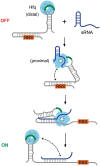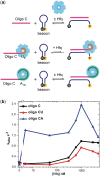Hfq proximity and orientation controls RNA annealing
- PMID: 22761405
- PMCID: PMC3458560
- DOI: 10.1093/nar/gks618
Hfq proximity and orientation controls RNA annealing
Abstract
Regulation of bacterial gene networks by small non-coding RNAs (sRNAs) requires base pairing with messenger RNA (mRNA) targets, which is facilitated by Hfq protein. Hfq is recruited to sRNAs and mRNAs through U-rich- and A-rich-binding sites, respectively, but their distance from the sRNA-mRNA complementary region varies widely among different genes. To determine whether distance and binding orientation affect Hfq's chaperone function, we engineered 'toy' RNAs containing strong Hfq-binding sites at defined distances from the complementary target site. We show that RNA annealing is fastest when the distal face of Hfq binds an A-rich sequence immediately 3' of the target. This recruitment advantage is lost when Hfq binds >20 nt away from the target, but is partially restored by secondary structure that shortens this distance. Although recruitment through Hfq's distal face accelerates RNA annealing, tight binding of six Us to Hfq's proximal face inhibits annealing. Finally, we show that ectopic A-rich motifs dramatically accelerate base pairing between DsrA sRNA and a minimal rpoS mRNA in the presence of Hfq, demonstrating that proximity and orientation predict the activity of Hfq on long RNAs.
Figures






Similar articles
-
Structure and RNA-binding properties of the bacterial LSm protein Hfq.RNA Biol. 2013 Apr;10(4):610-8. doi: 10.4161/rna.24201. Epub 2013 Mar 27. RNA Biol. 2013. PMID: 23535768 Free PMC article. Review.
-
Conserved arginines on the rim of Hfq catalyze base pair formation and exchange.Nucleic Acids Res. 2013 Aug;41(15):7536-46. doi: 10.1093/nar/gkt521. Epub 2013 Jun 14. Nucleic Acids Res. 2013. PMID: 23771143 Free PMC article.
-
Positional effects of AAN motifs in rpoS regulation by sRNAs and Hfq.J Mol Biol. 2014 Jan 23;426(2):275-85. doi: 10.1016/j.jmb.2013.08.026. Epub 2013 Sep 16. J Mol Biol. 2014. PMID: 24051417 Free PMC article.
-
Acidic Residues in the Hfq Chaperone Increase the Selectivity of sRNA Binding and Annealing.J Mol Biol. 2015 Nov 6;427(22):3491-3500. doi: 10.1016/j.jmb.2015.07.010. Epub 2015 Jul 18. J Mol Biol. 2015. PMID: 26196441 Free PMC article.
-
Cycling of RNAs on Hfq.RNA Biol. 2013 Apr;10(4):619-26. doi: 10.4161/rna.24044. Epub 2013 Mar 6. RNA Biol. 2013. PMID: 23466677 Free PMC article. Review.
Cited by
-
Structure and RNA-binding properties of the bacterial LSm protein Hfq.RNA Biol. 2013 Apr;10(4):610-8. doi: 10.4161/rna.24201. Epub 2013 Mar 27. RNA Biol. 2013. PMID: 23535768 Free PMC article. Review.
-
Global discovery of bacterial RNA-binding proteins by RNase-sensitive gradient profiles reports a new FinO domain protein.RNA. 2020 Oct;26(10):1448-1463. doi: 10.1261/rna.076992.120. Epub 2020 Jul 9. RNA. 2020. PMID: 32646969 Free PMC article.
-
Hfq binding changes the structure of Escherichia coli small noncoding RNAs OxyS and RprA, which are involved in the riboregulation of rpoS.RNA. 2013 Aug;19(8):1089-104. doi: 10.1261/rna.034595.112. Epub 2013 Jun 26. RNA. 2013. PMID: 23804244 Free PMC article.
-
Conserved arginines on the rim of Hfq catalyze base pair formation and exchange.Nucleic Acids Res. 2013 Aug;41(15):7536-46. doi: 10.1093/nar/gkt521. Epub 2013 Jun 14. Nucleic Acids Res. 2013. PMID: 23771143 Free PMC article.
-
Caulobacter crescentus Hfq structure reveals a conserved mechanism of RNA annealing regulation.Proc Natl Acad Sci U S A. 2019 May 28;116(22):10978-10987. doi: 10.1073/pnas.1814428116. Epub 2019 May 10. Proc Natl Acad Sci U S A. 2019. PMID: 31076551 Free PMC article.
References
-
- Kaberdin VR, Blasi U. Translation initiation and the fate of bacterial mRNAs. FEMS Microbiol. Rev. 2006;30:967–979. - PubMed
Publication types
MeSH terms
Substances
Grants and funding
LinkOut - more resources
Full Text Sources
Other Literature Sources
Research Materials

